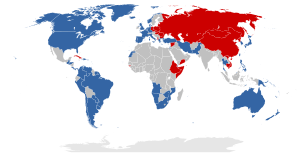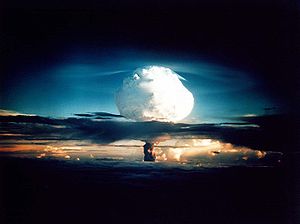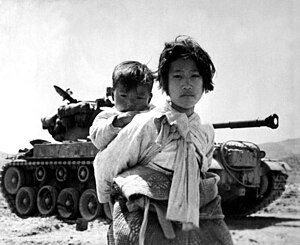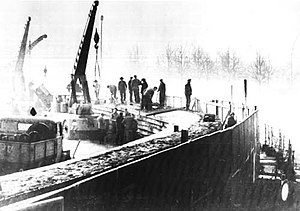Humanities Homework Help
Baton Rouge College The Cold War and Civil Rights Discussion Questions
What was the Cold War? What gains were made in decolonization and Civil Rights and who were some of the leaders?
please answer this question in page in half -2 pages 6 paragraphs 500-1000 words double spaced One full page and more. Please use all pf the internet for your research. Make sure to add the key components for example
– paragraph 1- What was the Cold War? 100-200 words
– Paragraph- 2 Who was involved -200-300 words
– Paragraph 3 What gains were made in decolonization- 200-300 words
– paragraph 4 Civil Rights and who were some of the leaders?- 200-300 words
-paragrapah-5 what was cause and effects- 200-300 words
Paragraph -6 conclusion of war – 100-300 words
The 45-year standoff between the West and the U.S.S.R. ended when the Soviet Union dissolved. Some say another could be starting as tensions with Russia rise.
Cold War1947–1991
Part of the Post-WWII era
NATO and Warsaw Pact states during the Cold War-era

The “Three Worlds” of the Cold War era, April – August 1975 First World: Western Bloc led by the United Statesand its allies
Second World: Eastern Bloc led by the Soviet Union, China (Independent), and their allies
Third World: Non-Aligned and neutral countries

Mushroom cloud of the Ivy Mike nuclear test, 1952; one of more than a thousand such tests conducted by the US between 1945 and 1992

With her brother on her back, a Korean girl trudges by a stalled American M46 Patton tank, at Haengju, South Korea, 1951

East German construction workers building the Berlin Wall, 1961

A US Navy aircraft shadowing a Soviet freighter during the Cuban Missile Crisis, 1962

American astronaut Thomas P. Stafford (right) and Soviet cosmonaut Alexei Leonov (left) shake hands in outer space, 1975

Soviet frigate Bezzavetny bumping USS Yorktown, 1988

The fall of the Berlin Wall, 1989

Tanks at Red Square during the August Coup, 1991
Part of a series onHistory of the Cold War
showOrigins
showPeriods
showRelated topics
The Cold War was a period of geopolitical tension between the United States and the Soviet Union and their respective allies, the Western Bloc and the Eastern Bloc, which began following World War II. Historians do not fully agree on its starting and ending points, but the period is generally considered to span the 1947 Truman Doctrine (12 March 1947) to the 1991 Dissolution of the Soviet Union (26 December 1991).[1]The term cold war is used because there was no large-scale fighting directly between the two superpowers, but they each supported major regional conflicts known as proxy wars. The conflict was based around the ideological and geopolitical struggle for global influence by these two superpowers, following their temporary alliance and victory against Nazi Germany in 1945.[2] Aside from the nuclear arsenal developmentand conventional military deployment, the struggle for dominance was expressed via indirect means such as psychological warfare, propaganda campaigns, espionage, far-reaching embargoes, rivalry at sports events and technological competitions such as the Space Race.
The Western Bloc was led by the United States as well as the other First World nations of the Western Bloc that were generally liberal democratic but tied to a network of the authoritarian states, most of which were their former colonies.[3][A] The Eastern Bloc was led by the Soviet Union and its Communist Party, which had an influence across the Second World. The US government supported right-wing governments and uprisings across the world, while the Soviet government funded communist parties and revolutions around the world. As nearly all the colonial states achieved independence in the period 1945–1960, they became Third World battlefields in the Cold War.
The first phase of the Cold War began shortly after the end of the Second World War in 1945. The United States and its allies created the NATO military alliance in 1949 in the apprehension of a Soviet attack and termed their global policy against Soviet influence containment. The Soviet Union formed the Warsaw Pact in 1955 in response to NATO. Major crises of this phase included the 1948–49 Berlin Blockade, the 1927–1949 Chinese Civil War, the 1950–1953 Korean War, the 1956 Hungarian Revolution, the 1956 Suez Crisis, the Berlin Crisis of 1961 and the 1962 Cuban Missile Crisis. The US and the USSR competed for influence in Latin America, the Middle East, and the decolonizing states of Africa and Asia.
Following the Cuban Missile Crisis, a new phase began that saw the Sino-Soviet split between China and the Soviet Union complicate relations within the Communist sphere, while France, a Western Bloc state, began to demand greater autonomy of action. The USSR invaded Czechoslovakia to suppress the 1968 Prague Spring, while the US experienced internal turmoil from the civil rights movement and opposition to the Vietnam War. In the 1960s–70s, an international peace movement took root among citizens around the world. Movements against nuclear arms testing and for nuclear disarmament took place, with large anti-war protests. By the 1970s, both sides had started making allowances for peace and security, ushering in a period of détente that saw the Strategic Arms Limitation Talks and the US opening relationswith the People’s Republic of China as a strategic counterweight to the USSR. A number of self-proclaimed Marxist regimes were formed in the second half of the 1970s in the Third World, including Angola, Mozambique, Ethiopia, Cambodia, Afghanistan and Nicaragua.
Détente collapsed at the end of the decade with the beginning of the Soviet–Afghan War in 1979. The early 1980s was another period of elevated tension. The United States increased diplomatic, military, and economic pressures on the Soviet Union, at a time when it was already suffering from economic stagnation. In the mid-1980s, the new Soviet leader Mikhail Gorbachev introduced the liberalizing reforms of glasnost(“openness”, c. 1985) and perestroika (“reorganization”, 1987) and ended Soviet involvement in Afghanistan. Pressures for national sovereignty grew stronger in Eastern Europe, and Gorbachev refused to militarily support their governments any longer.
In 1989, the fall of the Iron Curtain after the Pan-European Picnic and a peaceful wave of revolutions (with the exception of Romania and Afghanistan) overthrew almost all communist governments of the Eastern Bloc. The Communist Party of the Soviet Union itself lost control in the Soviet Union and was banned following an abortive coup attempt in August 1991. This in turn led to the formal dissolution of the USSR in December 1991, the declaration of independence of its constituent republics and the collapse of communist governments across much of Africa and Asia. The United States was left as the world’s only superpower.
To be Black in America is to fight. Even as the Founding Fathers wrote the documents that would ensure liberty to all men – The Declaration of Independence and The Constitution – the freedom of the Black man had already been taken hostage. Since then, men and women have led the Black community in the fight to regain this freedom in every form. Culminating in the 1950s and 1960s, the Civil Rights Movement characterized the middle of the 20th century. In schools around the country time is devoted to learning about this period in history, though with the exclusion of God from public schools it is difficult to paint an accurate picture of the movement. Many ignore the significance of Christianity to the Civil Rights Movement and the incredible role the Bible played in Martin Luther King, Jr.’s rhetoric, yet it is impossible to understand the desperation of this demand for freedom or the conviction of Martin Luther King Jr. without careful consideration of the impacts of these entities on the progress of Black America.

Image courtesy of http://webquestholes.blogspot.
com/jim-crow-laws.html
Political freedom was denied to Black men and women. The unjust remnants of slavery ran rampant in America. The nation supported the enduring problem of racial injustice that was manifested in segregation, discrimination, poverty, and domestic exile. Jim Crow laws provided a legal basis for discriminating against African-Americans and perpetuated the relegation of Blacks to second class citizenship in every facet from the military to education. The self-evident truths of equality and unalienable rights mentioned in the Declaration of Independence were quite foreign to those with brown skin. It is in such times, writes Hannah Arendt, that men retreat from the world in order to find freedom within. This happens in order to escape from the external forces that commandeer freedom such that one might feel free in spite of his bondage. The withdraw from the world in which freedom is denied allows the individual to occupy a self-fabricated space in which freedom is absolute. This space shelters him and denies access to anyone or anything that threatens his freedom. However, this is not the form of freedom that matters. Political freedom is of the utmost importance. In fact, Arendt writes that the “raison d’etre of politics is freedom” (145). Without the stage of the public sphere, freedom cannot appear. This sphere is the platform from which every man can raise his voice and be granted equal merit. When a man exercises his virtuosity by acting upon the opportunities the world presents, he exhibits freedom; “for to be free and to act are the same” (151).
By the 1950s, any contentment associated with the development of inner freedom was overcome by the desire to gain political equality. Black Americans, led by Martin Luther King Jr., claimed freedom for themselves by organizing and engaging with the government. Though they did not have the same rights as other citizens, they used their actions to speak. The Black Church provided much of the rationale and motivation for the liberation activities (Pinn 220). Countless Black preachers claimed that the Bible, especially the Gospels, called Christians to work for the betterment of African Americans. They preached that true Christianity demanded attention to and effort toward the liberation of oppressed peoples and the recognition of our innate equality in God’s eyes, as beings created in his image (Pinn 224). Martin Luther King Jr. even proclaimed that “any religion which professes to be concerned about the souls of men and is not concerned about the social and economic conditions that scar the soul, is a spirituality moribund religion” (“My Pilgrimage”). Parishioners were convinced to become activists not in spite of their religion but because of it (Pinn 220).

By Danny Lyon, from Memories of
the Southern Civil Rights Movement, courtesy Edwynn Houk Gallery
Though Martin Luther King is often given the credit for developing a nonviolent strategy, it can be traced back to the New Testament. Matthew recounts Jesus teaching this very philosophy: “You have heard that it was said, ‘Eye for eye, and tooth for tooth.’ But I tell you, do not resist an evil person. If someone strikes you on the right cheek, turn to him the other also…” (Matthew 5:38-39). It is incompatible to preach the Gospel while retaliating in violence. Many church leaders desired to emphasize the nation’s failure to treat all its citizens in accordance with God’s righteousness rather than retaliate in violence (Pinn 222). Some did attempt to reconcile retaliation with the Church such as the National Committee of Negro Churchmen, but few Black churches gave much attention to their philosophies (Pinn 222).
The Black Church was also instrumental in organizing the community. The Church was able to harness inspirational preaching and to translate it into deliberate action; in this way, it served to mobilize parishes, towns, and even cities. Even when facing police brutality, church bombings, and assassination attempts, King and other preachers affirmed the message that nonviolence was the greatest weapon they possessed in the quest for justice and equality. As a result, many attendees adopted similar thoughts.
The Black Church is also largely responsible for forming leaders like Martin Luther King Jr. King was a deeply spiritual man. As a child he attended numerous services a week and was hungry for scripture and theology (Miller 406). He was a student of the Word and recognized the ongoing process of understanding Scripture. As a preacher, King was an exemplary and prophetic voice of the Church. He expanded the discussion of civil rights beyond that of race, urging the Church to “make the gospel relevant” (Baldwin 28). The Church should not only stand for civil rights, but it should use its own vast resources to help improve quality of life for all. This echoes the sentiment of John’s first epistle where it is written, “If anyone has material possessions and sees his brother in need but has no pity on him, how can the love of God be in him Dear children, let us not love with words or tongue but with actions and in truth” (3:17-18). King’s goal was to create a better America all around, not just in issues of race and ethnicity.
In his sermon “Paul’s Letter to American Christians”, King addresses the aforementioned issues in greater detail. Not only does he preach the scripture, he intentionally sounded like scripture. (This style is one with which most of his audience would identify.) As gleaned from the title of the sermon, this message was delivered in the spirit of a letter from the Apostle Paul. The letter opens just as Paul’s epistles did: “I, an apostle of Jesus Christ by the will of God, to you who are in America. Grace be unto you, and peace from God our Father, through our Lord and Savior, Jesus Christ”. “Paul” marvels at the scientific and technological strides that have been made during the nearly 2000 years since his last letter appeared in the New Testament, but, in light of the pervasive injustice, asks America if “moral progress lags behind your scientific progress”. Paul then explains how Christians are to live in the midst of a non-Christian world. The message mirrors that of Jesus when he spoke, “If you belonged to the world, it would love you as its own. As it is, you do not belong to the world, but I have chosen you out of the world” (John 15:19a). Paul emphasized that Christians are not to seek man’s social approval at the expense of the “eternal demands of the Almighty God” to stand against institutions that are in conflict with God. This may not lead to societal approval, but it is pleasing to God who is the highest authority.

By Flip Schulke
“Paul’s Letter to American Christians” also directly addressed the struggle of the Black man. Paul drew on his previous letters to annihilate the argument that Blacks are inferior because of Noah’s curse upon the children of Ham (Genesis 9:20-27). Paul writes that this is blasphemy for “there is neither Jew nor Greek, slave nor free, male nor female, for you are all one in Christ Jesus” (Galatians 3:28). He urges Americans to rid the country of every form of segregation in recognition of the unity found in Christ. Finally, he encourages Americans to face these issues in love. The theme originally expressed in 1 Corinthians 13 is reiterated in Paul’s final petition to Christians: all the good in the world “amounts to absolutely nothing devoid of love” (“Paul’s Letter…”). King’s narrative was the chase for liberation; his motive was love. For every sermon or speech that King made, the call for action was always love.

Jack Mulcahy, Chicago Tribune historical photo
In his most famous speech, “I Have a Dream”, at the March on Washington for Jobs and Freedom, King draws heavily from religious texts. Without recognizing the Biblical allusions, it is impossible to glean from this speech all that King intended. This speech is modeled upon the tradition of African American religious rhetoric. King draws a comparison between the Hebrew bondage in Egypt and then Babylon and the African American bondage in America. This was a metaphor with which the audience would have been familiar. The comparison had been drawn since the days of slavery. Many claimed Blacks had a “fascination with Moses and the Pharaoh,” but King again extended the story to the present day (Miller 408).
King also integrated quotations from the Book of Amos into “I Have a Dream”. To close his “We are not satisfied” litany he incorporated a quote from Amos 5:24: “And we will not be satisfied until justice rolls down like waters and righteousness like a mighty stream.” To many (especially current readers) this just seemed like a beautiful use of metaphor, but to the listening audience, this was prophecy. This is a call for justice as in the days of Moses. And just as God delivered Moses, listeners believed that God would deliver them from their bondage. King was deliberate in framing scripture, though. Surrounding the Amos passage King quoted are verses of God’s disgust with and rejection of his people. In fact, Amos 5:24 is more accurately described as an expression of God’s wrath than it is of hope and equality. They speak of the things God hates and despises, how he will not accept offerings, and of how the day of the Lord will be darkness (Amos 5: 18-22). But King avoids those verses. Instead he creates marvelous illustrations of harmony and peace:
I have a dream that one day this nation will rise up and live out the true meaning of its creed: We hold these truths to be self-evident that all men are created equal…
I have a dream that one day even the state of Mississippi, a state sweltering with the heat of injustice, sweltering with the heat of oppression, will be transformed into an oasis of freedom and justice.
I have a dream that my four little children will one day live in a nation where they will not be judged by the color of their skin but by the content of their character. I have a dream today!…
I have a dream that one day every valley shall be exalted, and every hill and mountain shall be made low, the rough places will be made plain, and the crooked places will be made straight, and the glory of the Lord shall be revealed and all flesh shall see it together.
This is our hope. This is the faith that I will go back to the South with. With this faith we will be able to hew out of the mountain of despair a stone of hope… knowing that we will be free one day…this will be the day when all of God’s children will be able to sing with new meaning, “My country ’tis of thee, sweet land of liberty, of thee I sing. Land where my fathers died, land of the Pilgrim’s pride, from every mountainside, let freedom ring!” And if America is to be a great nation, this must become true. (“I Have A Dream”)
King did not promote a society without race; rather, he described a world in which racial differences no longer elicited hateful and harmful consequences because of the abundance of harmony and good will. That vision is still the greatest portrayal of what America can and should be, and was certainly worthy of a litany of hope and faith followed by a poetic celebration of freedom, but he is clear that the realization of that dream is contingent upon the disappearance of racism (Miller 411). In the above passages, King appeals not just to the Founding Fathers, but to God the Father and the equality he has given each of his children. Metaphors are in nearly every line making it beautifully poetic. Again, a Biblical allusion is integrated so smoothly it is difficult to notice. The prophet Isaiah first used similar language (every valley shall be exalted…) as he foresaw John the Baptist who would prepare the way for the Lord Jesus. Here, the way was being prepared for justice.

Flip Schulke / Corbis
A gift that King had was his ability to reenergize sacred stories from centuries ago. Just as he transported Paul to the twentieth century, he also transported Moses. King drew from Biblical texts that celebrated “the journey of an entire people from slavery to freedom, from wilderness to the Promised Land, and from exile back to the homeland” (Miller 413). King cast the events of the Civil Rights Movement in light of the Bible. He reimagined the Exodus, pulling it from its original context and exchanging the Hebrews for Black America. In this historical context, those supporting the continuation of racial injustice were pharaohs; the great marches from Selma to Montgomery, Alabama for voting rights symbolize the Exodus from Egypt; the battered and bruised Black men and women were the suffering Israelites; and King was the Black Moses, the liberating agent, who was willing to die so that his people might live to see the fullness of their Promised Land (Lischer). It may seem like this is not a position someone would choose for himself or an entire people, but King knew the ending of the Exodus. Therefore, he realized that “to live faithfully in any oppressive Babylon is to abide in Pharaoh’s Egypt while awaiting a planetary and human (re)birth and (re)emancipation” (Miller 414). The Hebrew narrative offered promise, not further disaster.
Though America was rightfully the land of African

 Talk to us support@bestqualitywriters.com
Talk to us support@bestqualitywriters.com